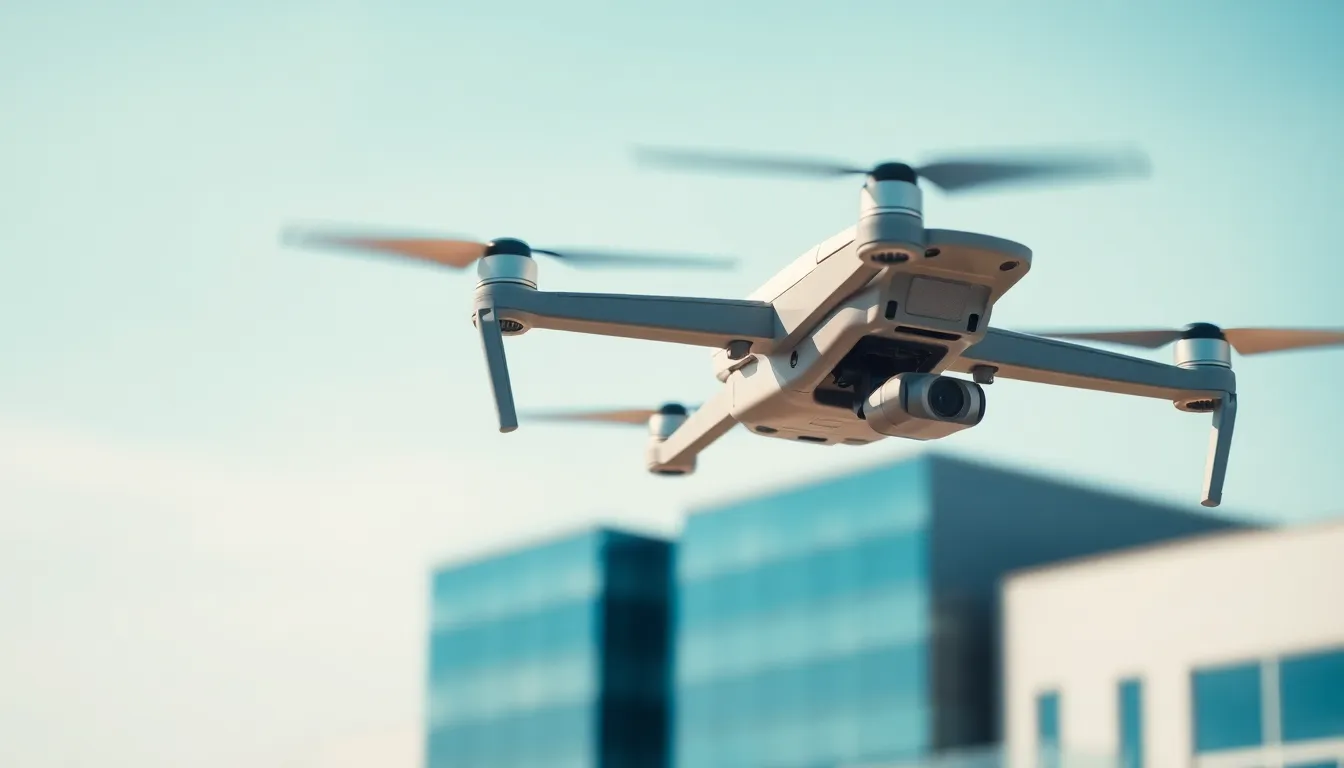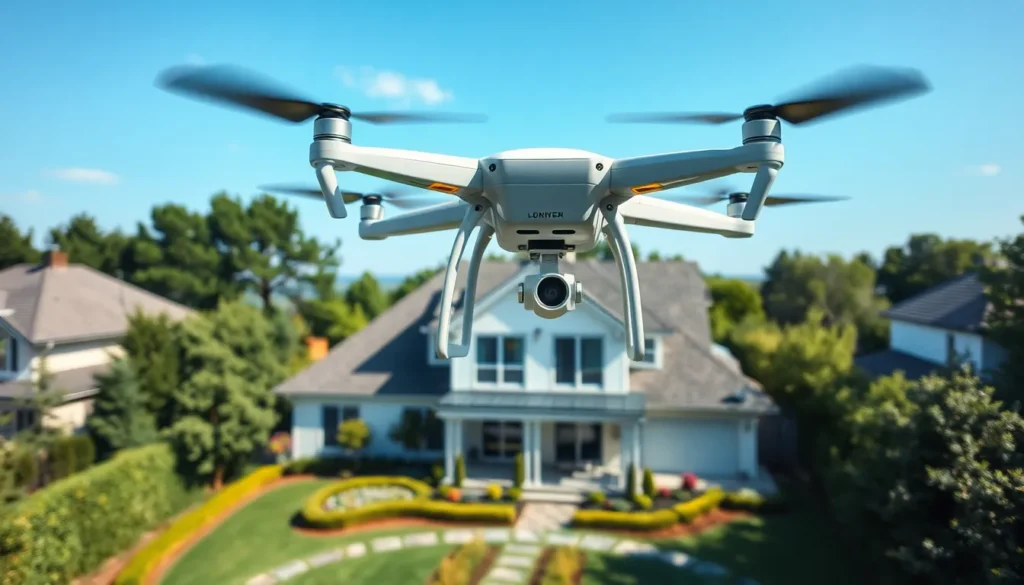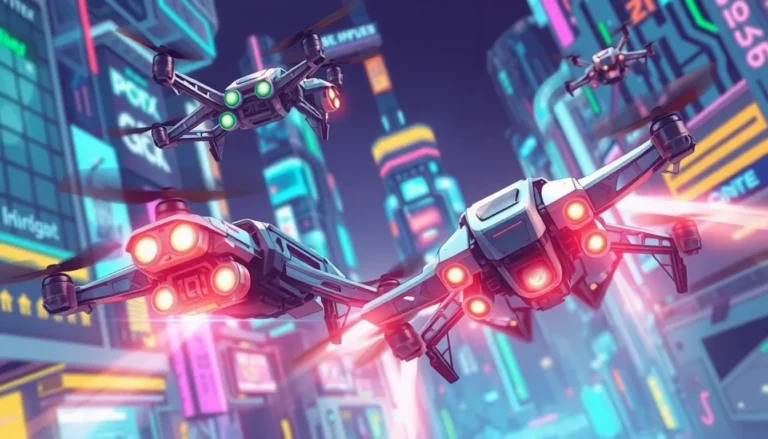Table of Contents
ToggleIn a world where drones buzz around like over-caffeinated bees, security has never been more crucial. Imagine a fleet of high-tech eyes in the sky, tirelessly watching over your property while you kick back and enjoy your favorite show. Drone security systems are here to save the day, combining cutting-edge technology with a sprinkle of futuristic flair.
Overview of Drone Security Systems
Drone security systems utilize advanced technology to enhance property monitoring and protection. These systems integrate features such as high-definition cameras, sensors, and real-time data analysis. Homeowners experience increased peace of mind, knowing their properties are under constant surveillance.
High-definition cameras play a critical role in monitoring by capturing detailed images. Sensors detect movement, triggering alerts for any unusual activity. Real-time data analysis allows for immediate responses to potential threats, ensuring quick intervention.
Many drone security systems offer remote access via mobile devices. Users can view live feeds and receive notifications from anywhere. This flexibility enables proactive measures against security breaches.
Innovative technology such as artificial intelligence enhances the efficiency of these systems. AI algorithms analyze patterns in behavior, distinguishing between normal activity and potential security risks. This intelligent monitoring reduces false alarms, allowing for focused responses.
Pilot programs and testing demonstrate the effectiveness of drone security systems in various environments. Homes, businesses, and large estates benefit from the mobility and versatility of drones. These systems adapt to different layouts and security needs.
Integration with existing security measures strengthens overall protection. Linking drones with alarms, locks, and other surveillance tools creates a comprehensive security network. This layered approach addresses diverse threats, from burglary to vandalism.
Growing adoption in both residential and commercial sectors indicates a shift toward modern security solutions. As drone technology continues to evolve, innovations such as automated patrol routes and enhanced battery life improve their reliability. The future of security management increasingly relies on these high-tech solutions to safeguard properties efficiently.
Types of Drone Security Systems

Drones offer various security solutions to meet diverse needs. Two primary categories include active surveillance systems and passive monitoring systems.
Active Surveillance Systems
Active surveillance systems provide real-time monitoring and immediate responsiveness. Equipped with high-definition cameras, drones can capture detailed video feeds and detect unusual activities. Often integrated with advanced analytics, these systems analyze live data to identify potential threats. Notifications alert users about security breaches as they occur, enabling prompt action. Enhanced control comes from remote access features, allowing users to manage surveillance through mobile devices. It combines mobility and technology for effective monitoring of extensive areas.
Passive Monitoring Systems
Passive monitoring systems operate differently by recording data for later review. Drones equipped with cameras capture footage, storing it for future access. These systems excel in environments with less immediate threat, functioning mostly in a support role. Users can review recorded footage to investigate incidents or confirm suspicions. While they lack the real-time alerts of active systems, they offer comprehensive documentation of security events. Ideal for businesses and residential properties, these systems maintain accountability and provide evidence when necessary.
Key Features of Drone Security Systems
Drone security systems offer vital capabilities for effective property monitoring and protection. Specific features contribute to their efficiency.
Real-Time Tracking
Real-time tracking enables immediate location updates of drone movements. Users access live flight paths through mobile applications, ensuring comprehensive oversight. Accurate GPS coordinates allow for precise monitoring of security zones. These systems respond quickly to unauthorized access or anomalies, enhancing overall security measures. Alerts notify users about movement outside designated areas, promoting timely interventions. Data transmission occurs seamlessly, providing consistent updates and enhancing reliability.
Intrusion Detection
Intrusion detection systems rely on advanced sensors to identify unusual activities. Motion detectors within drones trigger alerts when unexpected movements occur. Users receive notifications in real-time, facilitating prompt responses to potential threats. High-definition cameras capture crucial footage, documenting incidents as they unfold. AI technology analyzes patterns to differentiate between ordinary occurrences and legitimate threats. This capability significantly reduces false alarms, enhancing user trust in the technology. Together, these features create a robust defense mechanism against unauthorized access and security breaches.
Benefits of Implementing Drone Security Systems
Implementing drone security systems provides significant advantages for effective property protection. Enhanced efficiency and modern technology lead to improved security solutions.
Cost-Effectiveness
Cost-effectiveness stands out as a primary benefit of drone security systems. Traditional security measures often involve high installation and maintenance expenses. In contrast, drone systems reduce operational costs by minimizing the need for extensive manpower. While initial investment in technology may occur, long-term savings manifest through lower monitoring costs. Businesses and homeowners enjoy this economic advantage, as automated systems decrease the likelihood of theft and property damage. Data from pilot programs also suggests that areas utilizing drone security report reduced insurance premiums, further offsetting costs.
Enhanced Coverage
Enhanced coverage is another critical advantage provided by drone security systems. Drones can navigate various terrains and hard-to-reach areas, offering surveillance capabilities that ground-based systems often cannot match. With the ability to cover large properties quickly, they ensure no blind spots are left unattended. High-definition cameras paired with real-time tracking generate comprehensive visuals over expansive areas, allowing for thorough monitoring. Properties with multiple structures benefit from this increased surveillance, as drones systematically patrol and verify security integrity. Users gain peace of mind knowing their entire property remains monitored efficiently.
Challenges in Drone Security Systems
Drone security systems face several challenges that impact their deployment and effectiveness. Regulations and technological constraints significantly affect how these systems operate.
Regulatory Compliance
Regulatory compliance poses a significant challenge for drone security systems. Authorities enforce specific regulations concerning drone usage, including restrictions on flight paths and zones. Adherence to local laws becomes crucial to avoid legal complications. Users need to stay informed about changing legislation that governs airspace rights and privacy concerns. Education on these regulations supports safe and responsible drone operation in various settings.
Technological Limitations
Technological limitations also hinder the effectiveness of drone security systems. Battery life often restricts flight time, impacting coverage without frequent recharging. GPS accuracy can vary in dense urban environments, leading to navigation issues. Weather conditions present further challenges, as drones may struggle in high winds or heavy rain, compromising surveillance capabilities. Integration with existing security infrastructures remains complex, potentially requiring additional adaptation and software updates. These technological hurdles demand ongoing innovation to enhance the reliability and performance of drone systems.
Drone security systems represent a significant advancement in property protection. By combining real-time monitoring with innovative technology they offer a proactive approach to safeguarding homes and businesses. Users benefit from enhanced surveillance capabilities and reduced operational costs while enjoying the peace of mind that comes with comprehensive coverage.
As the technology continues to evolve addressing regulatory and technical challenges will be crucial. Staying informed about these developments ensures users can maximize the benefits of drone security systems. The growing trend toward integrating these systems into existing security measures highlights their importance in modern security strategies. Embracing drone technology is not just about keeping properties safe; it’s about staying ahead in an ever-changing security landscape.







